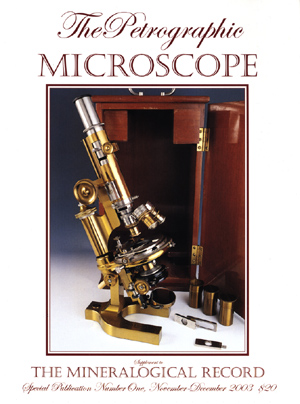“The Petrographic Microscope: Evolution of a Mineralogical Research Instrument” by Daniel E. Kile
The Petrographic Microscope:
Evolution of a Mineralogical Research Instrument.
by Daniel E. Kile
Special Publication No. 1, A Supplement to The Mineralogical Record, November-December 2003, The Mineralogical Record Inc., P.O. Box 35565, Tucson, Arizona 85740;
email: minrec@aol.com; telephone: 520-297-6709.
96 pages; 108 figures. Soft cover. US $20.00.

Let us, first of all, consider the specifics: the 96-page monograph starts with a two-page introduction, in which the author, who, incidentally, is with the U.S. Geological Survey, states his intention here of addressing the evolutionary form, function, and development of the petrographic microscope, and its accessories, through the late 1970s, while also placing these developments in the context of simultaneous developments of the sister sciences of mineralogy and geology; the contributions to our collective knowledge on the part of specific individuals are also incorporated.For those who knew of Dan Kile’s monograph in manuscript, the frustrating, long wait to realize funding for its printing is finally over – and the result was worth the wait! This beautifully produced publication is a rare treat for the eye, mind, and soul of the polarized-light microscopist in general, and for the mineralogist, historian of scientific instruments, and collector of petrographic microscopes in particular.
A four-page section then follows, which briefly describes the important features and characteristics of the Petrographic Microscope, including a photograph of the projection of interference figures on a hemisphere of pingpong ball.
The six-page Properties Observable with the Petrographic Microscope summarizes observations that are made with both plane-polarized and crossed analyzer/polarizer orthoscopic (parallel) light, and properties observed conoscopically (convergent light) with the Bertrand lens.
Pages 17-45 describe and illustrate the Historical Development of the Petrographic Microscope through the early 1900s and then into the 1970s. Here are the wonderful photos of specific instruments that make one’s heart beat a little faster; included also are several chromolithographs, photomicrographs, a poster reproduction, and a chronological table listing the Milestones in the Development of the Petrographic Microscope. The development of reflected-light techniques for the study of opaque ore specimens is also treated in this section.
Manufacturers of Petrographic Microscopes are discussed in pages 45-48, together with additional fine photos of their classic instruments.
The wide range of Accessories for the Petrographic Microscope are rather extensively described and illustrated in the next 30 pages. First of all, the common accessories are described – the wedges and the waveplates; then the detachable mechanical stage, and the rotational devices, including the one- and two-axis devices up through the universal stages with their many axes of rotation. Spindle stages of all kinds are next illustrated and described, from the very simple forms to the elaborate goniometer types. Integrating stages are then treated, followed by rotating compensators, comparator, and auxiliary devices for optimizing interference figures and measuring the optic axail angle. The Wright eyepiece gets a section of its own, and the following section on accessories for ore/reflected light microscopy includes the visual photometers, the elliptical analyzer, the Straumanis rotating stage, the Leitz 2-axis Universal Stage, and the microspectroscope. This chapter concludes with a discussion of sets of prepared microscope slides of minerals, grain mounts, thin sections, oriented crystal sections, and polished ore samples. Fine photographs illustrate each of these.
The monograph concludes with brief chapters on Evaluation and Restoration; Conclusions and Epilogue; Acknowledgements; and, finally, a valuable References section of just over 400 items.
A word is necessary about the publisher: this beautifully-produced monograph is the work of Mineralogical Record. For those readers not familiar with The Mineralogical Record, I strongly recommend considering a subscription; every issue is like a work of art, with detailed attention paid to every aspect of the production, from font selection and layout to exquisite photography. It is difficult to think of anybody else who has comparable skills to have produced this monograph. The November-December 1998 issue of The Mineralogical Record had an extensive, highly-illustrated article on goniometers. Together, the goniometer issue, and the present monograph on the petrographic microscope, are particularly splendid contributions, for which we must be grateful to both authors and publisher.
When one considers that Dan Kile’s monograph on The Petrographic Microscope costs only US $20, one has to realize what a terrific bargain this is. I have ordered extra copies for gift giving, and I know of at least one microscope manufacturer’s representative who is ordering these in quantity to give out with the purchase of every polarizing microscope. Highly recommended.
Comments
add comment